
Guests
- Monica Gandhiinfectious disease specialist, professor of medicine at the University of California, San Francisco, and a division head at San Francisco General Hospital.
As the official United States death toll from COVID-19 approaches 200,000 people, we speak with infectious disease expert Dr. Monica Gandhi, who says President Trump’s refusal to promote face masks has made the pandemic much worse. “Masks are a pillar of pandemic control. They are incredibly important,” says Dr. Gandhi, a professor of medicine at the University of California, San Francisco, as well as a division head at San Francisco General Hospital. “There is no country in the world right now that has been fighting masks like this, especially at the presidential level. If we could have started mask wearing, consistent mask wearing, at the beginning, we would have averted deaths and cases.”
Transcript
AMY GOODMAN: This is Democracy Now! The Quarantine Report. I’m Amy Goodman. As the official U.S. death toll from COVID-19 approaches 200,000, with more than 6.6 million reported cases, The Washington Post has revealed the White House scuttled a plan to distribute 650 million cloth face masks to every residence in the United States during the early weeks of the coronavirus pandemic. Vice President Pence and other officials rejected the proposal because, quote, “receiving masks might create concern or panic.” A draft press release about the plan from the U.S. Postal Service reads, “The first shipments are expected to reach U.S. households as early as April xx” — with the date left incomplete.
One study by the Center for Economic Policy Research found widespread mask use across the United States would have saved 40,000 lives in the months of April and May alone.
This comes as the head of the Centers for Disease Control and Prevention warned Wednesday U.S. residents should not expect to receive a vaccine for the coronavirus until at least mid-2021, contradicting President Trump’s claim at least 100 million doses could be distributed by the end of 2020. Dr. Robert Redfield was speaking at a Senate hearing on the federal government’s response to the pandemic.
DR. ROBERT REDFIELD: The face masks, these face masks, are the most important, powerful public health tool we have. And I will continue to appeal for all Americans, all individuals in our country, to embrace these face coverings. I’ve said that if we did it for six, eight, 10, 12 weeks, we’d bring this pandemic under control. These, actually, we have clear scientific evidence they work, and they are our best defense. I might even go so far as to say that this face mask is more guaranteed to protect me against COVID than when I take a COVID vaccine, because the immunogenicity may be 70%, and if I don’t get an immune response, the vaccine is not going to protect me. This face mask will.
AMY GOODMAN: President Trump lashed out at Dr. Redfield’s testimony, telling reporters in the White House press briefing room the top U.S. public health official misspoke.
PRESIDENT DONALD TRUMP: I think he made a mistake when he said that. It’s just incorrect information. And I called him, and he didn’t tell me that. And I think he got the message maybe confused.
AMY GOODMAN: Trump also contradicted the CDC director over masks, saying a vaccine would be much more effective than facial coverings at stopping the spread of the coronavirus. His comment came after Dr. Redfield estimated a potential coronavirus vaccine might only be 70% effective at generating an immune response, making widespread mask use critical to ending the pandemic. During a town hall event Tuesday on ABC hosted by George Stephanopoulos, Trump again downplayed the use of masks.
PRESIDENT DONALD TRUMP: There are a lot of people think the masks are not good. And there are a lot of people that — as an example, you have —
GEORGE STEPHANOPOULOS: But what are those people?
PRESIDENT DONALD TRUMP: I’ll tell you who those people are: waiters. They come over, and they serve you, and they have a mask. And I saw it the other day, where they were serving me. And they’re playing with a mask. I’m not blaming them; I’m just saying what happens. They’re playing with a mask. So, the mask is over, and they’re touching it, and then they’re touching the plate. That can’t be good.
AMY GOODMAN: Well, for more, we’re joined by Dr. Monica Gandhi, an expert in infectious diseases, professor of medicine and associate division chief of the Division of HIV, Infectious Diseases and Global Medicine at UCSF, San Francisco General Hospital.
Welcome to Democracy Now!, Dr. Gandhi. It’s great to have you with us.
DR. MONICA GANDHI: Thank you.
AMY GOODMAN: If you can respond to what President Trump is saying and how important you think masks are?
DR. MONICA GANDHI: Yes, I think this is great that you’re talking about this on this program, because masks are a pillar of pandemic control. They’re incredibly important. And there is no country in the world right now who has been fighting masks like this, especially at the presidential level. And if we could have started mask wearing, consistent mask wearing, at the beginning, we would have averted deaths and cases.
And, you know, one thing I do have to say, because I remember this day very well, the day that the CDC recommended population-level mask wearing, which was April 3rd, and the way it was told to us as the American public was by the president of the United States. And he came out at a press conference and said — held it up and said, “I think these are optional. I think it’s voluntary. And I’m not going to wear it.” And that way of messaging to the American public, including what you just said, over the last couple of months, has been very detrimental to our attempt to get universal mask wearing.
AMY GOODMAN: Why is it so critical what Trump has failed to do, and in so doing, puts out a very strong message? He refuses, consistently, to wear a mask, only a few times in all of the months of the pandemic. And the last time was in a hospital, so, you know, people do wear masks in hospitals. President Trump refuses to wear a mask. When questioned about whether he was endangering the thousands of people who come to see him at a rally who are largely maskless, he says, “Look at me. I’m socially distancing. I’m fine up here,” which is probably true. But they are not. They are not social distancing. They are not wearing masks. Explain, though it may be intuitively obvious to people, why masks make a difference, and when you came to this conclusion.
DR. MONICA GANDHI: You know, masks make a huge difference. I really — I don’t think I could stress how important I think this is as a pillar of pandemic control.
So, there are two reasons that masks work so very well. One is that, you know, when this started spreading, the coronavirus, so quickly, at January, February, March, people were like, “What could be happening?” People started talking about surfaces, fomites. You know, there was such confusion. And then really what happened is that it turns out — and we haven’t seen this for a long time in infectious diseases — that even though you feel well, you can shed the virus at high rates from your mouth and nose, even when you feel fine. And by definition, that asymptomatic spread means that if you cover your mouth and nose, which is where it’s coming out, that you can protect others. That’s one point about masking, that you protect others.
I think there was a problem at the beginning of the pandemic that we just messaged that these can protect others. We are not in a stage in our country that civic duty is working out really well for us. And to be honest, we should have probably messaged that it protects others and protects yourself. And where did we get the idea that it protects yourself? From decades of literature with other respiratory viruses that putting on a mask protects you. We had actually — totally, completely commonsense, actually. But the idea that it protects you is that you block the areas in which you’re most likely to imbibe the virus: your nostrils and your mouth. And so, we’ve actually started messaging in California, in San Francisco, where I live — we’ve changed our messaging to say “protect you, and protect others.”
So, there’s two huge imports of masks, which is that it protects others, it protects you. And if we could just wear this — and I really commend Dr. Redfield for saying it so forcefully, the clip that you just played on your program, two days ago to the Senate. If we could just do this consistently, we can get through this pandemic. There are other strategies, of course, but this is a pillar of pandemic control.
AMY GOODMAN: I mean, this is quite amazing, what Dr. Redfield said. He said this could be more effective — not just a supplement, more effective — than a vaccine. Talk about the effectiveness of masks —
DR. MONICA GANDHI: Yes.
AMY GOODMAN: — and why it matters, the whole issue of asymptomatic versus people who die.
DR. MONICA GANDHI: Yes, it means so much to mask. Now, there’s another theory that’s being propounded that it also helps decrease the severity of disease, because if you mask up, you get less viral particles in, and if you get less viral particles in — say that you are unlucky to get infected — you get less viral particles in, there is evidence from animal models and outbreak investigations and even country-level data that you’re less likely to get sick.
Of course it’s important to drive up the proportion of those who have asymptomatic infection. This is a deadly disease for some, and then, for others, they’re completely well. It’s actually really confusing and protean in its manifestations. Dr. Fauci has said this many times. How do you get people being completely well and some people being so ill? And so, anything that we can do to drive up the proportion of people who feel well, that’s exactly what we should be doing. And the important part about that is they can also spread it if they feel well. So masking is so incredibly important for the response.
There has never been a country where mask guidelines are announced by someone with reluctance, by someone who doesn’t model mask wearing. I can’t really stress the importance of modeling by public health leaders, by presidents, by mayors, by governors, to convince the populace that this is important. Raising questions on masks six months into the pandemic, when we have been the epicenter of the pandemic since March 26 — we have not moved from that dubious position. Literally, the pandemic actually was declared by the WHO on March 11th, because, before that, it was called a “global health emergency.” March 11th, pandemic; March 26th, the United States becomes the epicenter. And we haven’t budged from that position. We’re clearly doing many things wrong. But this mask wearing, if we could have just modeled it from the beginning — I’ve seen Trump and Pence in mask, I think, twice or thrice — it is so important. I really don’t know how to stress how important it is to model that for people in the country.
AMY GOODMAN: So, you mentioned other countries. Can you talk about what has been done in other countries and the proof that masks make a difference?
DR. MONICA GANDHI: Yes. I mean, actually, it’s so interesting, because no other country, hands down, has fought mask wearing like we have in the United States. And so, I give you two good examples, because I really like these examples. Taiwan, March 6, very early in the pandemic, they have a country near them in which the pandemic is still raging, which is China. They literally pull out all the stops and make factories and industry convert to mask wearing, because they knew about mask wearing since SARS, which was the pandemic in 2003. They mass-produced masks, and the populace wears them without debates like this, because it’s such an important pillar of control. And they have had a handful of deaths in a country of 23 million people. They hand out masks. They provide masks. They model mask wearing. They message mask wearing. They have billboards with mask wearing. It just wasn’t an issue. Same with actually many Asian countries — Vietnam, Thailand, Japan, Singapore, South Korea. From SARS, they knew how to mask.
And then, I like talking about the Czech Republic, because they weren’t affected by SARS in 2003, but they just figured it out, put out a mandate for mask wearing on March 23rd, also quite early in the pandemic. And they got through their pandemic so quickly. Everyone wore cloth face coverings. And by May 11th, they were like, “OK, we’re done. You can start taking off your face coverings.” They had such low death rates and such a good response. No one has fought it, though, like the United States. No one. So I can name many, many other countries where it’s not an issue.
AMY GOODMAN: So, your family is from India.
DR. MONICA GANDHI: Yes.
AMY GOODMAN: Can you talk about what’s happened in India, both the catastrophic numbers of cases and how that compares to the death toll — for example, in Mumbai?
DR. MONICA GANDHI: Yeah, that’s a very interesting question about India. And India is — it is catastrophic in terms of number of cases, because it is a very dense population, and it is a transmissible virus. It is very transmissible. The one cheap, easy thing we have available to us is mask wearing. And when we think about Mumbai — and, of course, Mumbai has the largest slums in the world — there is an ability not to socially distance, unfortunately, not to test and treat our way out of the pandemic. There is an ability to wear masks.
And there is a hypothesis that the relatively lower death rate compared to other places is that simple modality of taking a piece of cloth, which is very available to us in India, but — I mean, it’s part of the national costume — but taking the cloth and covering the face and nose. I think that places that have had lower death rates, there’s lots of hypotheses, because we thought it would be higher. And one is that there’s possibly cross-reactivity from other coronaviruses that people have been exposed to. And the other is this simple act of covering the nose and mouth.
AMY GOODMAN: Do you recommend certain kinds of masks?
DR. MONICA GANDHI: Yes. I mean, this is a great question about what kind of masks. The way that I think about it is that N95 masks are very tight-fitting. Those are the ones that we wear in the hospital. They are most effective at blocking out viral particles, but they’re very uncomfortable. I wore one the other day for like two hours, and it’s, like, really uncomfortable. They are very comfortable, and they do not lend themselves to wearing all day. We actually have to change our strategy, where we start thinking it is a piece of our clothing. And beyond that, we really do ask for N95 masks to be preserved for personal protective equipment for healthcare workers.
So, there’s two options, really, that — at least, again, from modeling from other respiratory viruses. We can never take people, you know, put masks on them and spray this virus into their face. That would be totally unethical. It’s a deadly virus. So, from other modelings, from animal studies, it really is two options, I think. One is a surgical mask, which is pretty easy to get. And then the second is a cloth face covering. And I’d recommend cotton with two ply, so not one, but two ply, that you can pull apart. Make it fit over your nose and mouth, so definitely have to bring it up over the nose, over the ears, and pretty snug fitting, if you can get it. And make it something that becomes part of your — I actually just bought, like, really pretty masks yesterday, and I was very excited that I now have masks that I’m really, like, kind of into. It’s increasing my compliance.
So, to be honest, like, we have to make it second skin for maybe a year. I mean, when Dr. Redfield said what he said about vaccines, when we think about preventative modalities for any infectious diseases, we don’t know when we’re going to get a vaccine. We have to do — we have to get to vaccines safely. We have to make them effective. They are not going to be 100% effective. Some vaccine trials have 50% as their vaccine efficacy standpoint. Seventy percent is what Dr. Redfield said, that we may have some that are 70%. You may need two doses. It may take a while to get to immunogenicity. You need some time. And we’re going to be wearing a mask that entire time. So make it comfortable. Make it cotton or a cloth.
AMY GOODMAN: Some researchers suggest that people who come into contact with infected people while wearing masks may receive a lower inoculum or dose of the virus, which could make them less likely to develop a severe case of COVID-19.
DR. MONICA GANDHI: Yes. That is really based on — it’s a theory, but I think it’s gaining a lot of observational evidence behind it, that the lower — that because a mask filters out the majority of viral particles, you get less in, if you do end up getting infected. And getting less in may lead to a less severe disease. So, we get that idea from animal models. Animal models, animals who get less virus in, they get less sick. Get an idea from hamsters — even when you give them less of the COVID virus, they get less sick. And then, as we’ve been watching outbreaks around the world, settings where you’re wearing a mask seem to drive down the severity of infection and drive up the rate of asymptomatic disease. More study is needed.
AMY GOODMAN: And what about how often you wear the same mask?
DR. MONICA GANDHI: Yes. I mean, they shouldn’t get wet or soiled. And really, I would wash them at least every other day. And —
AMY GOODMAN: That’s if they’re not paper.
DR. MONICA GANDHI: Yeah. Yes, exactly. So, paper, you can’t. You can’t wash them. So, take your, like, five or six cloth masks and wash them every day, keep them clean. And make it part of your day. Like, make it part of your costume.
AMY GOODMAN: Finally, I wanted to ask you — this was that town hall meeting held by ABC, President Trump repeating his claim that the coronavirus would just go away.
PRESIDENT DONALD TRUMP: We’re going to be OK. And it is going away. And it’s probably going to go away now a lot faster because of the vaccine. It would go away without the vaccine, George. But it’s going to go away a lot faster with the vaccine.
GEORGE STEPHANOPOULOS: It will go away without the vaccine?
PRESIDENT DONALD TRUMP: Sure, over a period of time. Sure, with time, it goes away.
GEORGE STEPHANOPOULOS: And many deaths.
PRESIDENT DONALD TRUMP: And you’ll develop — you’ll develop herd — like a herd mentality. It’s going to be — it’s going to be herd-developed.
AMY GOODMAN: A “herd mentality,” he said. That was President Trump, speaking with George Stephanopoulos, appearing to reference herd immunity.
And so, I wanted to go then to what’s happening in your neck of the woods, nearby at Stanford. President Trump’s personal lawyer, Marc Kasowitz, has threatened to sue scores of Stanford professors, epidemiologists, infectious disease docs, researchers, after they published an open letter denouncing the qualifications of Dr. Scott Atlas, a colleague at Stanford who is now advising Trump on the pandemic. Atlas is a neuroradiologist with no expertise in infectious diseases. He has pushed on Fox News for the controversial herd immunity strategy, which could result in deaths of millions of more Americans. In an open letter to the Stanford docs [sic] — the doctors wrote of Dr. Atlas, quote, “The guidance he is giving to the White House does not reflect sound epidemiological reasoning, nor is it consistent with the current body of scientific knowledge about COVID-19,” unquote.
Attorney Marc Kasowitz, who’s now representing Atlas, has threatened to sue the signatories of the open letter, has demanded a retraction by today, saying the letter maliciously defames his client. Stanford professor Michael Fischbach responded to the threat by writing on Twitter, “I stand by everything we said. More facts, more science. Less Kasowitz,” unquote.
And full disclosure: My brother, Dr. Steve Goodman, is a dean at the Stanford School of Medicine, one of the signatories of the letter.
But, Dr. Gandhi, could you respond to this? No masks and herd immunity?
DR. MONICA GANDHI: Yes. So, I don’t think those two things go together — no masks and herd immunity. So, what is herd immunity? It’s a true concept. It’s a very valid concept. The concept is that when more of the population becomes immune to the coronavirus or to any infection, that it’s — the virus is bopping around, it can’t find anyone to infect, and it will start slowing its spread.
However, there are two ways to get to herd immunity. One is letting natural infection rage. That is not something that we would do with an infection that is deadly to so many people. And the other is a vaccine that will make us immune.
And mask wearing, the reason it’s so important is, even if you get infected, if you get less of symptoms, then that would be another way that it’s possible that, with mask wearing, you have asymptomatic disease, and you can get to herd immunity. But letting — no masks and herd immunity, put together, is going to result in many more deaths. It’s just not sound.
AMY GOODMAN: And possibly millions of deaths?
DR. MONICA GANDHI: Possibly millions of deaths. It is not sound advice. I don’t understand being against masks and then being for immunity. I think you have to be for both.
AMY GOODMAN: So, and then you President Trump’s personal lawyer threatening to sue scientists who are raising this concern? How does this interfere with the scientific process?
DR. MONICA GANDHI: You know, at the moment, it is — actually, the beginning of the pandemic, I was excited that I’m an infectious disease doctor. I was like, “Wow! This is important. Like, I’m doing something that’s helpful.” To be honest, this has been so politicized and so strange to be an infectious disease doctor in the middle of a pandemic in Trump’s America, that it is — I actually used to be on Twitter, and three days ago I got off because I was getting threats about my propounding mask wearing. And I can’t — I couldn’t understand the threats.
By the way, masks don’t reduce oxygenation. Oxygen is really tiny; it can get through masks.
So, it is really difficult to be right now just like speaking clearly about a pandemic and having attacks. And so, these scientists are right that you have to just propound what’s right, what’s tried and true, public health principles, what we know about the infection. And that’s how you have to put forth knowledge. And the attacks and the conspiracy theories have been amazing. I’ve not seen anything like this.
AMY GOODMAN: Dr. Monica Gandhi, we want to thank you so much for being with us, a professor of medicine —
DR. MONICA GANDHI: Thank you.
AMY GOODMAN: — and associate division chief of the Division of HIV, Infectious Diseases and Global Medicine at University of California, San Francisco. That’s UCSF, San Francisco General Hospital.
Next up, as Hurricane Sally batters the Gulf Coast and climate-fueled wildfires continue to ravage the West, we’ll speak with David Goodrich, former climate scientist with NOAA — that’s the National Oceanic and Atmospheric Administration.


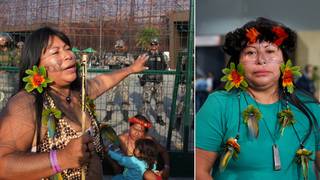
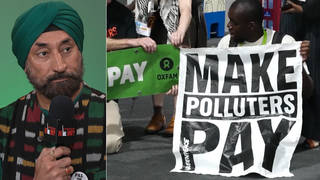
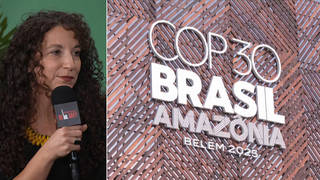





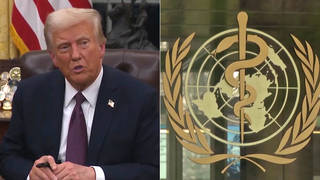
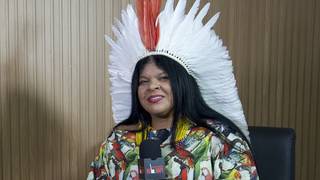
Media Options